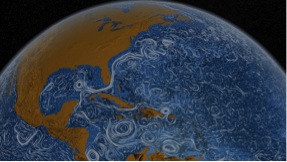
Ocean surface currents, including the Gulf Steam Current, from around the world
imaged between June 2005 through December 2007.
(NASA Goddard Photo and Video via Flickr/CC3.0 License)
Marine microbes play key roles in cycling carbon between the atmosphere and the ocean depths, but little is known about their populations throughout the waters. As global temperatures change, so do these populations, which in turn impacts their contributions to the carbon cycle.
Researchers want to learn more about these effects, but one of the challenges they face is that many of these microbes are uncultured. One approach they’ve used has been to study microbial communities. In a report published online September 11, 2012 in Current Biology, a team led by MBARI scientist and longtime DOE JGI collaborator Alex Worden focused on one such community from the Gulf Stream Current in the Atlantic Ocean.
From the metagenomic sequence generated and with the help of a technique called at-sea fluorescence activated cell sorting (FACS) , the researchers were able to assemble a complete chloroplast genome. In cyanobacteria, chloroplasts harness the sun’s energy to help produce nutrients for the cell. A comparative analysis with existing chloroplast genome sequences from the DOE JGI revealed that the chloroplast came from an uncultured tiny green alga.
The chloroplast genome allowed the researchers to determine that the alga they identified as a species of “wild Pelagomonas” is found around the world up to depths of around 75 meters. Based on “highly similar” genome sequences from the subarctic Pacific Ocean, the team reported, the Pelagomonasalga “may be performing a key ecosystem service by transporting atmospheric carbon it sequesters by photosynthesis into the deep ocean.”